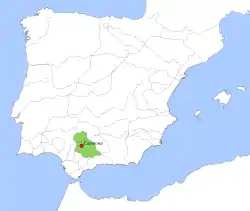Taifa of Carmona | |||||||||||
|---|---|---|---|---|---|---|---|---|---|---|---|
| 1013–1150 | |||||||||||
 Taifa Kingdom of Carmona, c. 1037 | |||||||||||
| Capital | Carmona, now in Seville, Andalusia, Spain | ||||||||||
| Common languages | Arabic, Mozarabic, Hebrew | ||||||||||
| Religion | Islam, Christianity (Roman Catholicism), Judaism | ||||||||||
| Government | Monarchy | ||||||||||
| Historical era | Middle Ages | ||||||||||
• Downfall of Caliphate of Córdoba | 1013 | ||||||||||
| 1066–1091 / 1091–1143 | |||||||||||
• Conquered by the Almohad Caliphate | 1150 | ||||||||||
| Currency | Dirham and Dinar | ||||||||||
| |||||||||||
Wikimedia Commons has media related to Taifa of Carmona.
The Taifa of Carmona (Arabic: طائفة قرمونة) was a medieval Berber taifa kingdom. It existed for two distinct periods: first from 1013 to 1066 when it was conquered by the Taifa of Seville, and secondly from around 1143 to 1150 when it was finally conquered by the Almohad Caliphate. The taifa was established and ruled by the Zenata Berber Birzalid dynasty.
Origins
The Banu Birzal was a Zenata Berber tribe settled in the Zab region and belonging to the confederations of the central Maghreb (Maghreb al-Awsat).[1][2]
List of emirs
Birzalid dynasty
Darddusid dynasty
- Darddus: fl. mid-12th century
- To Morocco: 1150–1248
See also
References
- ↑ Història d'Al-Andalus i del Magrib Xavier Ballestín Edicions Universitat Barcelona
- ↑ Al-Mansur y la dawla 'amiriya: una dinámica de poder y legitimidad en el occidente musulmán medieval Xavier Ballestín Edicions Universitat Barcelona,
37°28′00″N 5°38′00″W / 37.4667°N 5.6333°W
This article is issued from Wikipedia. The text is licensed under Creative Commons - Attribution - Sharealike. Additional terms may apply for the media files.